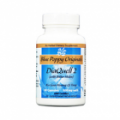DiaQuell 2
60 capsules x 5000mg. from Blue Poppy Originals
Indications: Diabetes mellitus, high cholesterol, obesity, and high blood pressure.
Applications in Traditional Chinese Medicine:
Pattern: An excessively phlegm damp bodily constitution with spleen vacuity, stomach and intestinal heat, blood stasis, and possible food stagnation resulting in metabolic syndrome (a.k.a. syndrome X).
Actions: Transforms phlegm and eliminates dampness assisted by fortifying the spleen and boosting the qi, clearing heat, dispelling stasis, and dispersing stagnation.
Classical antecedent: Ku Gua Huang Qi Tang, Momordica & Astragalus Decoction
THE SIGNS & SYMPTOMS OF PHLEGM DAMPNESS INCLUDE
Obesity
Profuse phlegm
A slippery pulse
Bodily heaviness
Thick, slimy tongue fur
THE SIGNS & SYMPTOMS OF SPLEEN VACUITY INCLUDE
Fatigue
A swollen, enlarged tongue with teeth-marks on its edges
Lack of strength
THE SIGNS & SYMPTOMS OF STOMACH AND INTESTINAL HEAT INCLUDE
Excessive appetite
Possible bleeding gums
Rapid hungering
Yellow tongue fur
Thirst with a desire to drink
A possibly rapid pulse
Possible constipation
THE SIGNS & SYMPTOMS OF BLOOD STASIS INCLUDE
Engorged veins, including spider nevi, varicose veins, and teleangiectasia
A purplish dark, possibly brownish skin discoloration (as in age spots)
A purplish tongue
A bowstring, possibly bound or intermittent pulse
THE SIGNS & SYMPTOMS OF FOOD STAGNATION INCLUDE
Bad breath
Abdominal distention
FORMULA RATIONALE
Metabolic syndrome is the combination of obesity, high cholesterol, insulin resistance, and high blood pressure. This syndrome is directly correlated to the incidence of life-threatening heart disease and stroke. In particular, the above formula addresses insulin resistance and diabetes mellitus in a person who is visibly overweight in their mid-section, so-called truncal or central obesity. In terms of Chinese medical patterns, this patient has lots of phlegm, dampness, and turbidity (i.e., the adipose tissue) plus stomach heat, spleen vacuity, a strong tendency to blood stasis, and the probable complication of at least some food stagnation. Therefore, within this formula, Huang Qi, Bai Zhu, and Cang Zhu fortify the spleen and boost the qi, move and transform phlegm and dampness, bank and supplement the middle burner. He Ye and Ju Hong aromatically penetrate and loosen the center, transform phlegm and disperse fat, and mildly diffuse the upper burner. Uncooked Pu Huang, uncooked Da Huang, Ji Nei Jin, and Shan Zha dispel stasis and transform phlegm, rectify the qi and disperse stagnation. Ze Xie blandly seeps and disinhibit waters, transforms phlegm and seeps dampness. Ku Gua, He Ye, and Da Huang clear heat from the stomach and intestines. Thus this formula treats all three burners.
In terms of pharmacodynamics, Huang Qi, Ze Xie, Bai Zhu, Cang Zhu, and Ku Gua have all demonstrated marked hypoglycemic effects. However, it is Ku Gua that has shown some of the best blood sugar lowering effects of any Chinese medicinal. To date, close to 100 in vivo studies have demonstrated the blood sugar-lowering effect of Ku Gua. In one comparative study, this herb performed better at lowering blood sugar than the hypoglycemic drug tolbutamide. This fruit has also shown the ability to enhance cells uptake of glucose, promote insulin release, and potentiate the effect of insulin. In other in vivo studies, Ku Gua has been shown to reduce total cholesterol. Further, yet other trials have shown that Ku Gua can reduce adiposity (fat) and blood pressure. He Ye suppresses appetite and promotes lipolysis, the breakdown of fat; thus it promotes weight loss. In addition, it reduces low-density lipids (LDL) while increasing high-density lipids (HDL). Shan Zha is also hypolipidemic, meaning that it too lowers blood lipid levels. It also improves the flow of the coronary arteries and lowers blood pressure.
CONTRAINDICATIONS
Hypoglycemia, anorexia, bulemia, chronic diarrhea
Ingredients:
Ku Gua (Fructus Momordicae Charantiae)
Huang Qi (Radix Astragali)
Bai Zhu (Rhizoma Atractylodis Macrocpehalae)
Cang Zhu (Rhizoma Atractylodis)
Ze Xie (Rhizoma Alismatis)
He Ye (Folium Nelumbinis)
Pu Huang (Pollen Typhae)
Shan Zha (Fructus Crataegi)
Ju Hong (Pericarpium Citri Erythrocarpae)
Da Huang (Radix Et Rhizoma Rhei)
Wu Wei Zi (Schisandra Chinensis fructus)
Tu Si Zi (Cuscuta Chinensis)
Dosage:
2 capsules 2 times a day
Package:
60 capsules x 5000mg. (500mg. x 10:1 concentration ratio)
Note: All Blue Poppy brand products come with the manufacturing date marked (MFG or Manuf. Date), the expiration date is 5 years from the date indicated on the bottom or side of the packaging.

